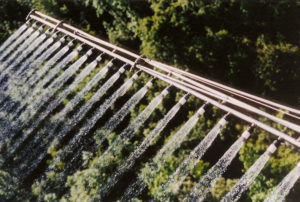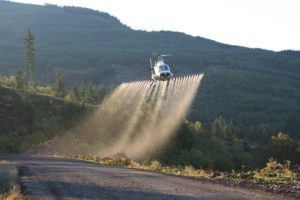Description
Helicopters with boom sprayers are well suited for use in mountainous areas, steep terrain, sites with highly irregular shapes and remote areas. They are highly maneuverable and apply sprays at much slower speeds than fixed-wing aircraft. Airspeed can vary from 30 to 80 mph but is about 45 mph for brush and weed spraying. To maintain precision application rates, aircraft should be equipped with variable-rate, flow-control units to compensate for changes in airspeed. GPS/GIS systems are helpful for precision applications. Spray tanks vary in size from 90 to 230 gallons, and the spray boom should not exceed 90% of the rotor diameter. Many types and sizes of nozzles are available.
Application
The conditions and regulations outlined in the fixed-wing aircraft section also apply to helicopters. Applications must follow the chemical’s Product Label, and the applicator must be certified by the state. Batch trucks that carry clean water and chemical mixing tanks for helicopters usually have landing pads atop the truck for convenience and safety in servicing. Ground personnel must always be alert to the helicopter’s moving rotors during servicing. Helicopters are more expensive to operate than fixed-wing aircraft, but they have the advantage of operating where fixed-wing aircraft cannot. Helicopters do not need landing strips and are adapted to remote rugged terrain and irregularly shaped sites. GPS/GIS units negate the need for flagmen in these remote sites and can record flight patterns.
References / Additional Information
Stevens, R.; Monsen, S.B. 2004. Chapter 9. Mechanical plant control. In: Monsen, S.B.; Stevens, R.; Shaw, N.L., comps. Restoring western ranges and wildlands, vol. 1. Gen. Tech. Rep. RMRS-GTR-136-vol-1. Fort Collins, CO: U.S. Department of Agriculture, Forest Service, Rocky Mountain Research Station. p. 65-88.




